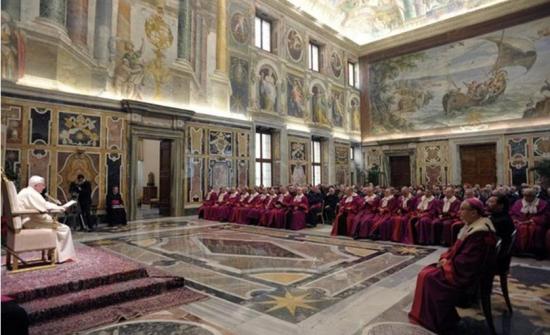Roman Rota
The Rota Romana is the Vatican appeal tribunal that grants an annulment if it decides that a marriage is invalid. When the two lower courts reach different verdicts over the validity of the marriage, appeal can be made to the Roman Rota. For all its pomp, the Rota Romana has been found by the European Court of Human Rights to violate the right to a fair trial.

The pope gives a speech to the Rota Romana every January before it starts its year’s
work in which he generally urges them to restrict the granting of marriage annulments.
In 2010 he warned the judges to adhere to church law and not go overboard
on “pastoral charity”, that is, not try too hard to further human happiness.
(Latin: rota romana, sometimes anglicised as Roman Rota)
The Judges of this tribunal serve by ratation, hence the name “rota”. The Rota Romana deals with annulments which are still contested after passing through the Diocesan courts (the first instance) and the Archdiocesan courts (the second instance). [1] The third instance of appeal is the Roman Rota. However, because the Rota Romana is more closely controlled by the Pope, it is stricter about granting annulments than American tribunals. Therefore, those contesting an annulment are advised to skip the second instance in the US and go straight to the Roman Rota. [2]
In 2001 the European Court of Human Rights found that the procedures of the Rota Romana failed to reach the standards required for a fair trial under article 6(1) of the European Convention and that, therefore, its judgments could not properly be recognized and enforced under Italian law. ECHR noted that, in Rota proceedings, witness statements were not provided to parties and that thus there was no opportunity for the parties to comment on them. Parties were not advised that they could appoint lawyers to appear for them, nor advised of the terms of the legal submissions made by the canon lawyer appointed by the court to argue against annulment. Finally, the parties were refused sight of a full copy of the Rota’s judgment, in which the ecclesiastical court set out its reasoning. Given these circumstances, the Strasbourg court took the view that justice was not done in annulment proceedings before church courts. (Pellegrini v. Italy (2002) 35 EHRR 2)
Technically, however, the European Court was obliged to fault Italy for enforcing the judgement of the Vatican court. This is because the Vatican couldn’t be censured for violating the European Convention on Human Rights, since it hadn’t signed it.
Notes
1. Fr. Paul Sretenovic, “Are Present Day Annulments To Be Taken Seriously?” Tradition in Action. http://www.traditioninaction.org/religious/k012rpAnnulments_Stretenovic.html
2. “What Every Respondent Needs to Know About the Annulment Process”, Save our Sacrament. http://www.saveoursacrament.org/BasicSteps.html







